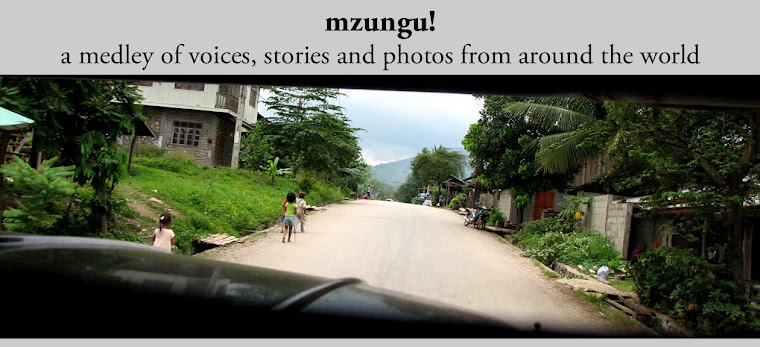(I wrote this piece--a "museum feature"--for a journalism class, but in an effort to write for more than my professor and a grade, I thought it could also make good blog material. You have the right to be offended at this article. Your comments most welcome.)
----
One summer during college I lived in a tiny village on a small river in Papua New Guinea, just north of Australia. There was no running water or electricity, but there was a lot of life. Games and music, food and laughter abounded. I learned about the “garamut,” a huge wooden slit-log drum that sent its resounding beats over the river’s surface to far-off huts, sending messages through specific rhythms.
That experience was about four years ago, so I was excited when I learned that Indiana University’s art museum has a South Pacific gallery. I went eagerly, anticipating that the art would evoke memories long buried.
I was not disappointed. As soon as I walked in the exhibit (and after the guard scolded me for having a backpack and writing with a pen), my eyes spotted a huge garamut. “Papua New Guinea, Murik peoples,” its placard read. “Slit gong. Wood, traces of pigment.” I could imagine its huge low sound carry over the waters. But here in the museum, it was silent and looked sad, its wood cracked and voice gagged.
That instrument used to be alive, but now it is an object of curiosity for the majority of visitors.
Feigning ignorance, I asked the gallery guard if he knew anything about it. “It sounds good,” he said. How does he know that? “I caught a few people playing.” Caught them and scolded them. This is an object of curiosity, remember? It’s a museum piece, not an instrument to send messages.
As I continued on through the gallery, my feelings of discontinuity increased. Those pieces were made by villagers for daily use—for games and music, food and even sacred rituals. And there in the museum they were caged behind glass walls with no indication of how they lived and breathed in their original contexts. When you change the context, the meaning and value of a piece shifts radically. The articles become authoritative and stuck in time, as if those earrings were “the” jewelry in the Solomon Islands in the 19th century.
I came across a “figure for a sacred flute” from Papua New Guinea. When I was in the village, flutes were sacred instruments, only played by men, and usually taken out at night in the cover of darkness. Played in pairs of five or six, they had an ethereal sound that my western-trained musical ears never completely understood. They were mysterious and sacred. And there in the museum, bright lights exposed the mystery and cast away the sacredness. “Figure for a sacred flute,” visitors read as they pass by.
I also passed by, my heart getting heavier, and found a placard that read, “Alamblak people, Kariwari River.” Alamblak! Those are my friends! I still remember the Alamblak-language greetings. I lived on the Kariwari River. The “war and hunting spirit figure” looked familiar with its smooth carving and pointed features. A friend had given me a similar object when I left the village. There, those objects are actually used. And here in Indiana, they are behind glass.
I left the gallery with mixed emotions. I am glad that visitors can be exposed to other cultures and their objects. Yet when those pieces are behind glass panels with no contextual information to inform the visitor, they become “artifacts” and “objects” instead of necessary tools. They become secular and exposed instead of sacred and hidden. They become silenced instead of booming over the waters.
If you go to this exhibit, please learn about the culture at least a little first. Please take your time and imagine those artifacts in their place of origin. Close your eyes and listen for the garamut’s low beats pulsing across the river, sending messages that the “waitskins,” the anthropologists, were on their way to collect artifacts for the world to see.
20 February 2009
Subscribe to:
Post Comments (Atom)


You should send this essay to the director of the museum. It reminds me very much of how animal zoos have evolved. The traditional zoo is a series of "display cages" with a bored and utterly unnatural animal peering out at the peering-in zoo visitors. Everything about the animal's wildness is removed. The animals are probably living terrible life. Modern zoos, however, seek to place the animals in as natural a setting as possible given their inherently captive condition. So instead of a caged beast, one might or might not see a rare ungulate hiding in some very natural grassy habitats, free to wander. Obviously such a display limits the number of animals present, but it truly enhances the experience for both observer and observee, and helps to develop an appreciation for nature the and conservation of habitats. So: why couldn't the display of musical instruments be done in a similar vein? For example: if you are going to show the instrument behind a glass case, a video and audio recording should be going on at the same time to at least demonstrate that the instrument was alive and is a dynamic, not static object.
ReplyDeleteAnna,
ReplyDeleteThis is a wonderful piece. Thank you for sharing it! I agree with Mary, you should send it to the museum director. I had a similar feeling when I saw the great stone chimes in the museum in Taipei and while I had only read about them, encountering their size and magnificence made me want to actually hear them, but alas they were under glass and kept silent.
I finally got to hear a similar set in the bell museum in Beijing (and took some video) and they were released from their captivity in my mind and ear!